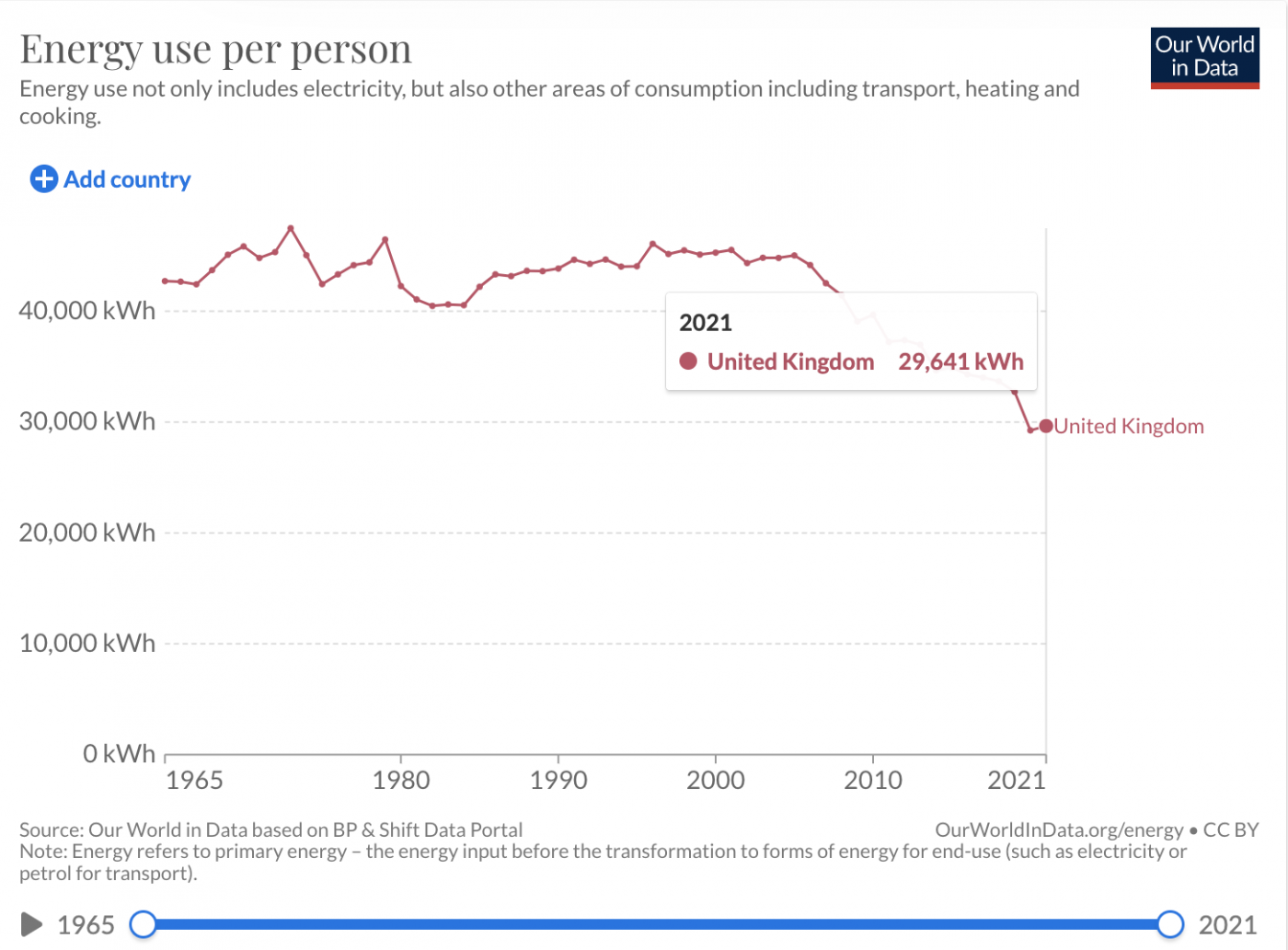The consumption of energy in the UK and Europe has experienced a gradual decrease in recent years. Despite this positive trend, there are numerous daily activities that could be accomplished with reduced energy usage. In our previous publication, we delved into the sources of energy and electricity production systems.
In this article, we shift our attention towards the electricity consumption of end users. The term “end user” refers to individuals in various settings such as offices, schools, factories, and educational centres who strive for increased efficiency, and reduced energy usage to save expenses, and promote sustainability.
Last week, we had a closer look at the UK’s electricity mix and we discussed that renewable energies constitute about 40% of the UK’s electricity generation and this proportion is steadily increasing. However, are these energy sources which generate the least emissions also the ones in greatest demand?
While you may not have a direct say in the production of the electricity you use, you can contribute to the cause by requesting cleaner sources and choosing a utility supplier that does not rely on polluting energies.
It is not always feasible for energy supply to be 100% green, as demonstrated in our previous article, due to various factors such as peak generation and the availability of renewable resources, as well as external factors. However, the greater the demand for green energy from consumers, the more companies will be incentivised to cater to these needs and satisfy customer preferences.
As an individual consumer, you may feel that your contribution is negligible. Nonetheless, by combining the efforts of larger consumers, such as corporations and manufacturers, the impact can be amplified significantly.
Energy Demand in the UK
Every activity needs energy nowadays. All economic activities, as well as our day-to-day personal and leisure activities. This needs for electricity or other energy sources are translated in the electricity sector into demand. And how much energy do users demand to carry out their activities?
This amount of energy usually follows certain patterns, influenced by seasonality, time of year, temperature, and light… With all these variables, energy demand varies during the months although year after year it repeats certain patterns. In the UK, the Office of Gas and Electricity Markets (OFGEM) regularly monitors electricity generation and demand. In addition to actual demand, it also calculates demand forecasts to ensure supply.
Why is this detailed control carried out? To ensure that generation is at approximately the same level as demand. As we have seen in other articles, electricity cannot be stored in large quantities, so generation and demand must be balanced to ensure supply.
Total Energy Consumption
Since 2000, per capita consumption has reduced by almost a third, resulting in 2.3 toe in 2021.
However, energy consumption rebounded by 4% (3.3% in normal climate) in 2021, reaching 160 Mtoe, after experiencing a 5% decrease in 2020 (11% in real climate). Over the previous 16 years, between 2003 and 2019, energy consumption had decreased at a rate of almost 2% per year.
Coal Consumption
Coal has been a major source of energy in the UK for many decades, but in recent years its use has declined significantly due to the rise of renewable energy sources and the government’s efforts to reduce greenhouse gas emissions. According to the Department for Business, Energy & Industrial Strategy (BEIS), coal consumption in the UK has decreased by more than 80% since 2012.
In 2021, the UK’s coal consumption was just 2.6 million tonnes of oil equivalent (Mtoe), down from 7.6 Mtoe in 2019. This decline was partly due to the COVID-19 pandemic, which led to a decrease in energy demand and therefore a decrease in coal consumption. However, the trend of declining coal use in the UK has been ongoing for several years, with coal consumption falling by around 60% between 2014 and 2018.
The decline in coal consumption in the UK has been driven by a combination of factors, including the closure of coal-fired power plants, the increasing use of natural gas, and the growth of renewable energy sources such as wind and solar power. In addition, the UK government has implemented policies to discourage the use of coal and promote cleaner energy sources. For example, a carbon tax has been introduced to make it more expensive to use high-emitting fuels like coal, and subsidies have been provided for renewable energy projects.
Electricity Consumption
Current energy demand figures are usually shown in gigawatt hours (GWh), and sometimes in megawatt hours (MWh) for days or months or in terawatt hours (TWh) for a year.
Electricity consumption in the UK has been steadily decreasing over the past few decades. According to the UK Department for Business, Energy & Industrial Strategy, in 2021, the total electricity consumption in the UK was 294.4 TWh. This is a slight decrease from the previous year, which saw consumption at 302 TWh, likely due to the Energy crisis.
As we can see on the graph, the energy use per capita has been decreasing for the past years, reaching 29’641 kWh in 2021. In Europe, on the other hand, electricity consumption per capita in the households sector in 2020 was much lower with 1.6 MWh per capita (1 596 kWh).
The majority of the UK’s electricity consumption is used by households and businesses. In 2021, domestic electricity consumption accounted for 38% of total consumption, while industrial and commercial consumption accounted for 29% and 28% respectively. The remaining consumption was from the transport sector, which accounted for 2% of total consumption, and 3% was classified as others.
Trends in Electricity Demand
The main trend in electricity demand today is a reduction in consumption.
Whilst there was some prior awareness concerning energy savings and efficiency, the COVID-19 pandemic of 2020 and the geopolitical circumstances since 2022 have given this movement a significant push. There is a growing sense of social and political responsibility in accordance with the Sustainable Development Goals (SDGs), which is leading to increased awareness.
As you may have observed in the previous section, the demand for electricity in the UK has been reduced somewhat timidly. This is not an isolated factor, however. Although digitalisation is driving us towards greater electricity needs (e.g. cooling, connectivity, screens), the more efficient our devices become and the more we optimise our electricity usage, the more we can achieve with less energy.
The goal is not to completely cease energy consumption, but rather to increase our awareness and reduce unnecessary energy usage.
Many European countries have implemented laws aimed at limiting or decreasing energy consumption. For instance, in the UK, there are a number of policies and initiatives in place that aim to reduce energy consumption and promote efficiency. Let’s have a closer look.
Trends in Electricity in the UK
- Reduction in consumption: The Energy Company Obligation (ECO) scheme requires energy companies to provide funding for energy efficiency measures in homes and other buildings. Additionally, the Minimum Energy Efficiency Standards (MEES) regulations set a minimum standard for energy efficiency in rental properties. The UK government has also established the Green Homes Grant scheme, which provides funding for homeowners to make energy-saving improvements to their properties. These are just a few examples of the efforts being made in the UK to reduce energy consumption and promote sustainability.
- Seasonal variations: Electricity demand in the UK also varies seasonally, with peak demand occurring in the winter months when households and businesses use more energy for heating. Summer demand is typically lower due to milder temperatures and reduced use of heating systems.
- Renewables are on the rise: The UK government has set a target to reach net-zero carbon emissions by 2050, which has led to a significant shift towards renewable energy sources such as wind, solar, and hydropower. As a result, there has been a decline in the use of traditional fossil fuels, which has impacted electricity demand. In 2021, renewable energy sources generated 42.9% of the UK’s electricity, a significant increase from 12.6% in 2012. Or in other words, in the same year, renewable energy sources generated 122 TWh of electricity in the UK, up from just 36.2 TWh in 2012
- Smart grids and storage: The UK is also investing in smart grid technologies and energy storage solutions to manage the intermittency of renewable energy sources. By the end of 2021, the UK had installed over 1.3 GW of battery storage capacity.
Energy Demand in the European Union
In 2021, electricity demand in the European Union (EU) stood at approximately 2,865 terawatt-hours. In 2020, electricity consumption amounted to 885 TWh in the industry sector, 677 TWh in the services sector, 714 TWh in the residential sector and 53 TWh in the transport sector.
The European Union places great emphasis on the reduction of pollutant gases and reduction of energy consumption in its Fit for 55 plans, including the reduction of emissions by 55% by 2023. Switching away from polluting energies and reducing final energy consumption will make a major contribution.
Demand has been reduced by as much as 10 per cent in some months, and the EU has proposed changes in this regard. Specifically, a 5% reduction in peak hours and a 10% reduction overall.
Energy Consumption Management with Dexma
Based on the macro data regarding demand in the UK and Europe, do you have an idea of how much energy you consume? Although we have been discussing large-scale data, it is possible that you haven’t had the chance to analyse your own consumption patterns closely, and therefore your figures may be lower.
Regardless of your current consumption rate, there are various opportunities to save energy in your business. By implementing small upgrades to your infrastructure, minimising unnecessary usage, and involving and educating your team, you can make progress towards your energy-saving goals. If this is a priority for your business, it’s time to take action. To explore the range of benefits that the Dexma Platform has to offer, click here.





